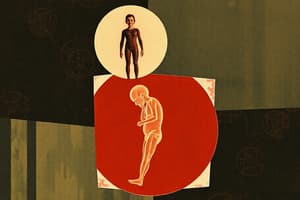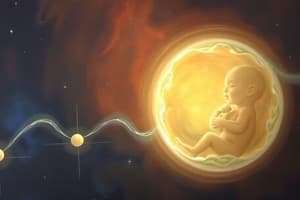Podcast
Questions and Answers
Match the following stages of development with their descriptions:
Match the following stages of development with their descriptions:
Zygote = Fertilized egg Embryo = Solid ball of cells at early stage of development Fetus = Embryo with all organs formed after 8 weeks Placenta = Structure attached to lining of uterus, provides oxygen and nutrients to embryo
Match the following structures with their functions:
Match the following structures with their functions:
Amnion = Fluid-filled sac protecting the embryo from damage Umbilical cord = Tube attaching embryo to placenta for nutrient exchange Heart = First organ to form in the embryo, pumps blood around the body Oviduct = Passageway for early embryo to travel to the uterus
Match the following terms with their meanings:
Match the following terms with their meanings:
Implantation = Process where embryo sinks into lining of uterus Amniotic fluid = Fluid surrounding embryo inside the amnion sac Placenta attachment = Connection between placenta and lining of uterus for nutrient transfer Carbon dioxide exchange = Transfer of waste product from embryo's blood to mother's blood
Match the following nutrients with their source for the embryo:
Match the following nutrients with their source for the embryo:
Match the following stages of development with their corresponding descriptions:
Match the following stages of development with their corresponding descriptions:
Match the following structures with their functions during embryonic development:
Match the following structures with their functions during embryonic development:
Match the following processes with their descriptions during embryonic development:
Match the following processes with their descriptions during embryonic development:
Match the following terms with their meanings related to embryonic development:
Match the following terms with their meanings related to embryonic development:
Match the following structures with their roles in supporting embryonic growth:
Match the following structures with their roles in supporting embryonic growth:
Match the following roles with their contributions to embryonic development:
Match the following roles with their contributions to embryonic development:
Match the following substances with their roles in supporting embryonic life:
Match the following substances with their roles in supporting embryonic life:
Match the following structures with their protective functions for the developing embryo:
Match the following structures with their protective functions for the developing embryo:
Match the following developmental milestones with their corresponding descriptions:
Match the following developmental milestones with their corresponding descriptions:
Flashcards are hidden until you start studying
Study Notes
Fertilization and Embryo Development
- Fertilized egg (zygote) divides into two cells, then four cells, and continues to divide and grow into a solid ball of cells.
- The embryo travels down the oviduct to the uterus and sinks into the lining, a process called implantation.
Embryo Growth and Development
- After 8 weeks, the embryo is called a fetus, and all organs are formed.
- The heart is one of the first organs to form and pumps blood around the embryo's body.
- The embryo becomes enclosed in a fluid-filled sac called the amnion or water sac, protecting it from damage and unequal pressures.
Placenta and Umbilical Cord
- The oxygen and food needed for the embryo's growth come from the mother's blood through the placenta.
- The placenta is attached to the embryo by the umbilical cord and allows oxygen, nutrients, and waste to be exchanged between the mother and embryo.
- Blood from the mother does not mix with the embryo's blood in the placenta.
Development Timeline
- Figure 4.15 shows the human embryo's development from 5 to 35 weeks, surrounded by the amnion and placenta.
Studying That Suits You
Use AI to generate personalized quizzes and flashcards to suit your learning preferences.




